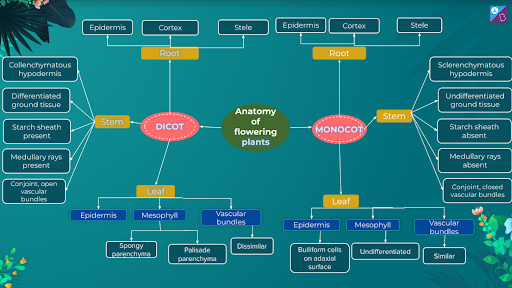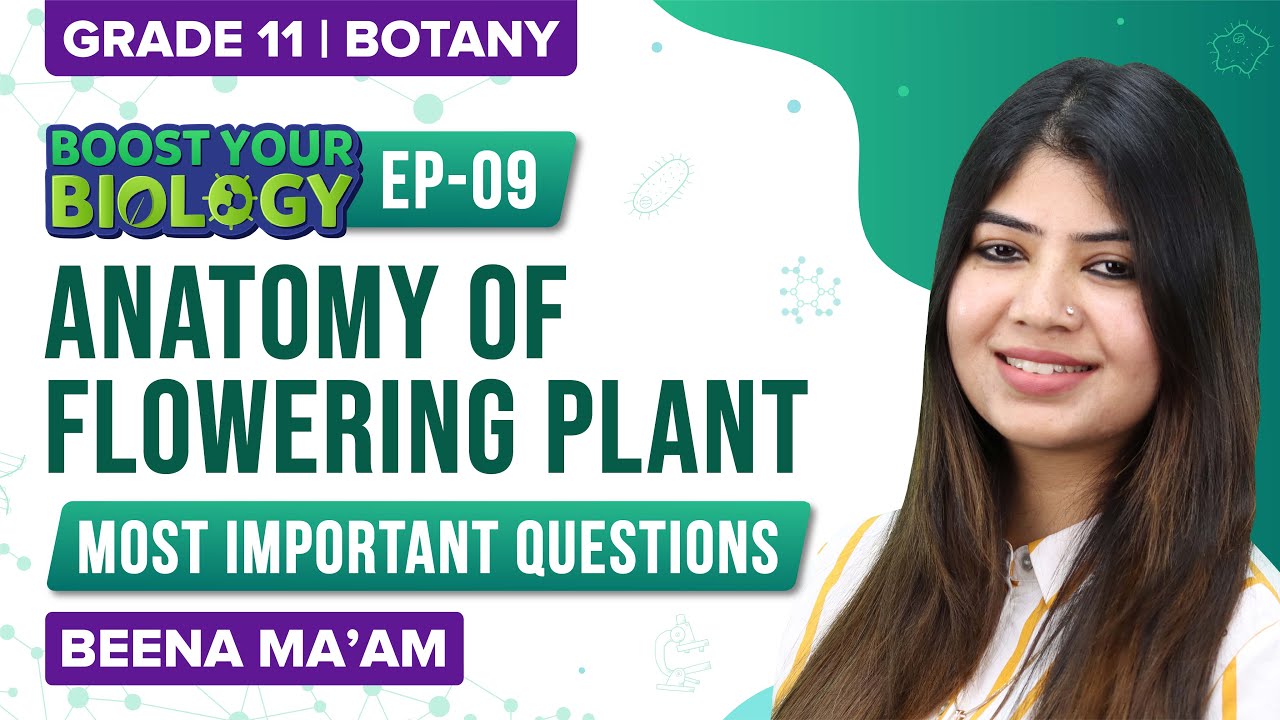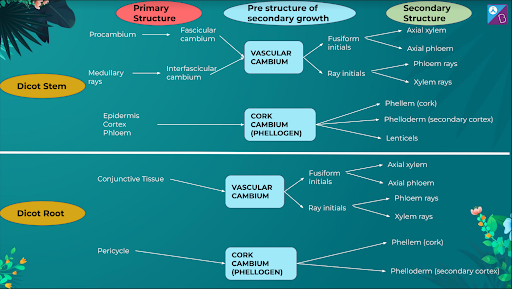Find below the important notes for the chapter, Anatomy of Flowering Plants as per NEET Biology syllabus. This is helpful for aspirants of NEET and other exams during last-minute revision. Important notes for NEET Biology- Anatomy of Flowering Plants covers all the important topics and concepts useful for the exam. Check BYJU’S for the full set of important notes and study material for NEET Biology and solve the NEET Biology MCQs to check your understanding of the subject.
Download Complete Chapter Notes of Anatomy of Flowering Plants
Download Now
| Name of the NEET sub-section | Topic | Notes helpful for |
| Biology | Anatomy of Flowering Plants | NEET exams |
Anatomy of Flowering Plants – Important Points, Summary, Revision, Highlights
Anatomy of Flowering Plants
Cells with the same structure and functionality constitute a tissue
Plants tissues are of two types:
- Meristematic tissue: cells divide actively
- Apical meristem– occurs at the tip and produces primary tissues, e.g. dermal, vascular and ground tissues
- Intercalary meristem– occurs in grasses between matured tissues
- Lateral meristem– produces secondary tissues, e.g. cambium
- Permanent tissue: cells, which don’t divide further after attaining their specialised structure and function
- Simple tissue: only one type of cells having the same structure and function
- Complex tissue: more than one type of cells that work in coordination
Do Check: NEET 2022 Answer Key With Solutions
| Permanent Tissue | Name | Structure | Function |
| Simple Tissue | Parenchyma | -cells are mostly isodiametric
-thin cell wall made up of cellulose |
-photosynthesis, secretion, storage |
| Collenchyma | -closely packed cells with no intercellular spaces
-deposition of cellulose, hemicellulose and pectin in the cell wall |
-mechanical support
-chloroplast containing cells assimilate food |
|
| Sclerenchyma | -elongated cells with thick lignified cell wall
-dead cells with no protoplasm -present as fibres or sclereids |
-provide mechanical support
-present in the seed coat, pulp and walls of fruits |
|
| Complex tissue | Xylem | -made up of tracheids, vessels, xylem fibres and xylem parenchyma
-vessels and tracheids are the main transporting material -two types of primary xylem, protoxylem and metaxylem -in stem endarch organisation with protoxylem at the centre -in roots exarch organisation |
-conducts water from roots to stem and leaves |
| Phloem | -in angiosperms, phloem is made up of companion cells, sieve-tube elements, phloem parenchyma and phloem fibres
-in gymnosperm instead of sieve tube and companion cells, albuminous and sieve cells are present -phloem parenchyma is absent in monocotyledons |
-transports food |
Epidermal Tissue System
- It comprises the outer covering of the plants, such as epidermis, cuticle, stomata, epidermal extensions; trichomes in stem and root hairs
- Stomata regulate gaseous exchange and water loss by transpiration
- Guard cells are bean-shaped in dicots and contain chloroplasts
- Grasses have a dumb-bell shaped guard cells
- Root hairs are unicellular
- Trichomes are multicellular
The ground Tissue System
- They form the major bulk of tissues between epidermal and vascular tissues, e.g. cortex, pericycle, pith
- It contains simple tissues
- Mesophyll of leaves is a ground tissue with chloroplast
The Vascular Tissue System
- It consists of complex tissues of xylem and phloem
- Dicots have cambium present between xylem and phloem of vascular bundle
- Cambium forms secondary vascular tissues
- Dicots have an open vascular bundle
- Monocots have a closed type of vascular bundle, i.e. cambium is absent
- Roots have a radial arrangement of vascular bundles, i.e. xylem and phloem are present alternatively
- Stem and leaves have a conjoint arrangement of vascular bundles, i.e. xylem and phloem are present at the same radius
Below is a infographics that can help you to revise the plant tissue system in a few minutes.
Dicotyledonous Root
- Epiblema is the outermost layer, which contains root hair
- Several layers of cortex present, that ends with innermost layer endodermis, which contains waxy material called suberin forming Casparian strips
- Next is pericycle, which gives rise to lateral roots and vascular cambium
- Two to six vascular bundles are present
- Radial and exarch vascular bundles
Monocotyledonous Root
- The structure is similar to dicot root but polyarch xylem bundles are present
- Pith is large and no secondary growth
Dicotyledonous Stem
- The outermost layer is the epidermis with cuticle
- Trichomes and stomata may be present on the epidermis
- The cortex consists of three layers; outermost hypodermis (collenchymatous), middle parenchymatous cortical layer and the endodermis containing starch grains
- Below endodermis, pericycle and radially located medullary rays are present
- Vascular bundles are arranged as a ring
- Vascular bundles conjoint, open and with endarch protoxylem
Monocotyledonous Stem
- Hypodermis is sclerenchymatous
- Vascular bundles are scattered, conjoint and closed
Dicotyledonous Leaf
- Also known as dorsiventral leaf due to distinct dorsal and ventral side
- Reticulate venation
- The epidermis covers both the upper and lower surface
- There are more stomata present on the abaxial epidermis
- Mesophyll cells are parenchymatous and perform photosynthesis
- The mesophyll is made up of elongated palisade and oval or round spongy parenchyma cells
- Vascular bundles are surrounded by bundle sheath cells and present on veins and mid-rib
Monocotyledonous Leaf
- Also known as isobilateral as both sides are similar
- Parallel venation
- Stomata are equally distributed on both sides
- The mesophyll is not differentiated between palisade and spongy parenchyma cells
- Some cells of the epidermis are modified into large cells called bulliform cells in grasses, they help in minimising water loss
- Vascular bundles are of the same size
Find this infographic that points out the differences between dicot and monocot roots, stems and leaves.

Recommended Videos:


Secondary Growth
- Secondary growth is due to dividing lateral meristems; vascular and cork cambium
- It is characterised by an increase in the thickness (girth)
- In the dicot stem, a ring of cambium is formed from intrafascicular cambium present between xylem and phloem and the medullary cells present adjoining the two vascular bundles that become meristematic
- The cells, which cambium forms towards the periphery, form secondary phloem and form secondary xylem towards the pith
- Cambium is very active during spring and forms earlywood or springwood, which has more xylary elements, light in colour and with low density
- Latewood or autumn wood is formed during winters when cambium is less active. The autumn wood is dense and dark in colour
- These form alternate light and dark annual rings, which help in predicting the age of the tree
- Heartwood is formed due to the deposition of tannins, raisins, oils and gums in the secondary xylem. It is hard, durable and resistant to insects
- The peripheral region of secondary xylem conducts water and lighter in colour and known as sapwood
- Cork cambium develops in the outer cortex region. It is also known as phellogen
- Phellogen divides on both sides, differentiating into outer cells are called phellem or cork and the inner cells are known as phelloderm or secondary cortex
- Suberin deposition the cell wall of cork makes it waterproof
- All the tissue exterior to vascular cambium are called bark including secondary phloem
- Lenticels present on the epidermis help in gaseous exchange
- Secondary growth is absent in monocots but present in gymnosperms
Quickly revise the concpet of secondary growth in dicot stem and root with this infographic.

Explore the next chapter for important points with regards to the NEET exam only at BYJU’S. Check the NEET Study Material for all the important concepts and related topics.
Also see:
Flashcards Of Biology For NEET Anatomy Of Flowering Plants
NEET Flashcards: Plant Kingdom
NEET Flashcards: Morphology Of Flowering Plants
NEET Flashcards: Photosynthesis In Higher Plants
NEET Flashcards: Respiration In Plants


Please give me zoology videos for NEET preparation
Explore videos here: https://byjus.com/neet/neet-quiz-videos/